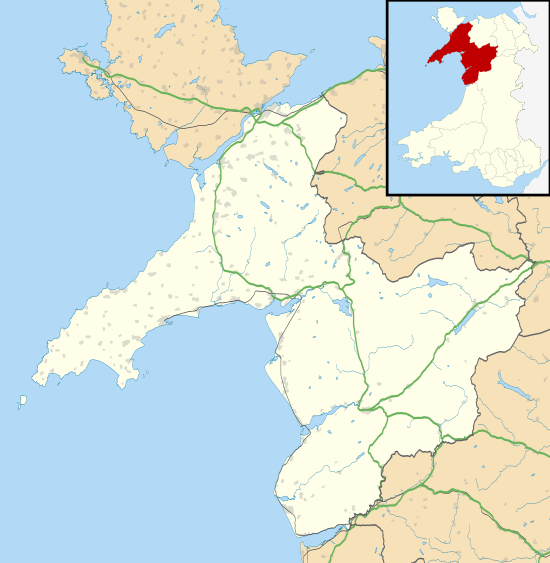RAF Towyn
Royal Air Force Towyn or more simply RAF Towyn is a former Royal Air Force airfield located 10.3 miles (16.6 km) west of Machynlleth, Powys and 12.2 miles (19.6 km) north of Aberystwyth, Ceredigion, Wales.
| RAF Towyn | |||||||||||
|---|---|---|---|---|---|---|---|---|---|---|---|
| Tywyn, Gwynedd in Wales | |||||||||||
 Looking south westwards over what was the grassed runway area for aircraft at RAF Towyn | |||||||||||
 RAF Towyn Shown within Gwynedd | |||||||||||
| Coordinates | 52°35′38″N 004°05′53″W | ||||||||||
| Type | Royal Air Force airfield | ||||||||||
| Site information | |||||||||||
| Owner | Air Ministry | ||||||||||
| Operator | Royal Air Force | ||||||||||
| Site history | |||||||||||
| Built | 1939 | ||||||||||
| In use | 1940-1945 | ||||||||||
| Airfield information | |||||||||||
| Elevation | 4 metres (13 ft) AMSL | ||||||||||
| |||||||||||
It was operational from 1940 and closed in 1945.
History
The camp was opened on 8 September 1940 as an Anti-Aircraft Co-operation unit for nearby Tonfanau under No.70 Group Army Co-operation Command (AACU).[1] The main function of the Flights on the base was to tow targets for the AACU at Tonfanau.[2]
In December 1943, No 1603 and 1628 Flights were disbanded and joined together to form No. 631 Squadron (RAF).[3] This Squadron stayed at Towyn until May 1945 when it moved on to RAF Llanbedr and the base was closed to flying soon afterwards.[4]
The base continued to be a military working environment being used periodically over the years.
The following units were here at some point:[5]
- 'C' Flight of No. 1 Anti-Aircraft Co-operation Unit RAF (1 AACU).[5]
- 'U' Flight of 1 AACU .[5]
- No. 6 Anti-Aircraft Co-operation Unit RAF.[5]
- No. 8 Anti-Aircraft Co-operation Unit RAF.[5]
- No. 1605 (Anti-Aircraft Co-operation) Flight RAF[5]
- No. 1628 (Anti-Aircraft Co-operation) Flight RAF[5]
- No. 631 Squadron RAF[6]
- Aberystwyth UAS[5]
References
Citations
- Phillips, Alan (2012). Welsh Military Airfields Through Time. Stroud: Amberley. p. 78. ISBN 9781445609935.
- Smith, George (November 2004). "Tywyn Coastal Protection Scheme: Archaeological Assessment" (PDF). Herwales.co.uk (in English and Welsh). Gwynedd Archaeological Trust. p. 7. Archived from the original (PDF) on 4 March 2016. Retrieved 2 August 2016.
- "No 631 Sqn". Royal Air Force. Royal Air Force. Retrieved 2 August 2016.
- Delve, Ken (2007). The military airfields of Britain: Wales and West Midlands. Marlborough: Crowood Press. pp. 317–318. ISBN 978-1-861269-17-1.
- "Towyn". Airfields of Britain Conservation Trust. Retrieved 31 March 2015.
- Jefford 1988, p. 101.
Bibliography
- Jefford, C G (1988). RAF Squadrons. A comprehensive record of the movement and equipment of all RAF squadrons and their antecedents since 1912. Shrewsbury: Airlife. ISBN 1-85310-053-6.
External links
